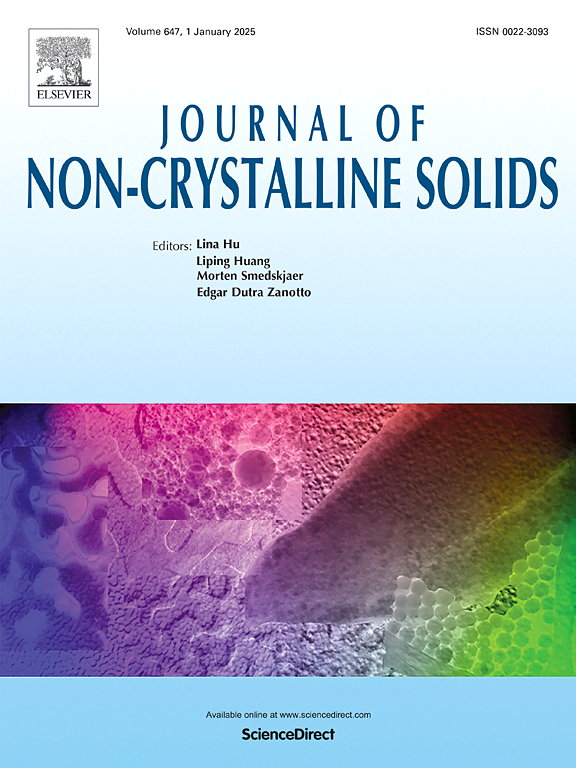在PMMA中掺杂不同浓度的TiO2纳米粒子对其结构、热性能和光学性能的影响
IF 3.5
3区 材料科学
Q1 MATERIALS SCIENCE, CERAMICS
引用次数: 0
摘要
本研究的目的是分析由二氧化钛掺杂的聚甲基丙烯酸甲酯制备的纳米复合薄膜的宏观结构、热性能和光学性能。傅里叶变换红外光谱(FTIR)分析表明,tio2纳米粒子的加入完全分散到PMMA基体中,导致PMMA振动峰的宽度、强度和位置发生了显著变化。采用差热分析(DTA)和热重分析(TGA/DTGA)对合成的纳米复合膜的热稳定性进行了研究。DTA结果中热峰的熔点、面积和形状不同,表明结晶度不同。热重分析表明,纳米复合材料分三个阶段分解,热稳定性较好。在可见光区测量了薄膜的透光率、吸收光谱和反射光谱。当tio2纳米粒子浓度增加到8 wt %时,透射率降低,吸收率增加,达到最大不透明度(≈27%)。线性光学参数表明,随着tio2纳米粒子掺入PMMA基体的增加,吸收系数、消光系数、折射率、介电常数和光电导率均有所增加。掺入TiO2NPs后,其Urbach能值从0.220 eV增加到0.247 eV(≈12%),而直接带隙值从2.910 eV减少到2.899 eV,间接带隙从2.615 eV减少到2.568 eV,表明PMMA基体中存在结构缺陷。利用Wemple-DiDomenico模型,计算了TiO2NPs的线性色散参数、线性光磁化率和非线性光学性质(如第三阶非线性光磁化率和非线性折射率)是TiO2NPs浓度的函数。结果表明,所制备的纳米复合薄膜在光电领域具有广阔的应用前景。本文章由计算机程序翻译,如有差异,请以英文原文为准。

Impact of doping different concentrations of TiO2 nanoparticles to PMMA on its structural, thermal and optical properties for optical applications
The aim of the present work is to analyze the macrostructure, thermal and optical properties of nanocomposite films prepared from poly(methyl methacrylate) doped with titanium dioxide using solution casting process for optoelectronic applications. The films were examined using Fourier transform infrared (FTIR) spectroscopy, which showed that the addition of TiO2![]() NPs completely disperses into the PMMA matrix and causes significant changes in the width, intensity and positions of PMMA vibration peaks. Differential thermal analysis (DTA) and thermogravimetric analysis (TGA/DTGA) were used to study the thermal stability of the synthesized nanocomposite films. The melting point, area and shape of the thermal peaks in the DTA results varied, indicating different levels of crystallinity. According to TGA analysis, the nanocomposites decomposed in three stages and were thermally stable. The optical transmittance, absorption and reflectance spectra of the films were measured in the visible region. As the concentration of TiO2
NPs completely disperses into the PMMA matrix and causes significant changes in the width, intensity and positions of PMMA vibration peaks. Differential thermal analysis (DTA) and thermogravimetric analysis (TGA/DTGA) were used to study the thermal stability of the synthesized nanocomposite films. The melting point, area and shape of the thermal peaks in the DTA results varied, indicating different levels of crystallinity. According to TGA analysis, the nanocomposites decomposed in three stages and were thermally stable. The optical transmittance, absorption and reflectance spectra of the films were measured in the visible region. As the concentration of TiO2![]() NPs increased to 8 wt %, the results showed that the transmittance decreases and the absorption increases, reaching the maximum opacity (≈27 %). The linear optical parameters showed that the absorption coefficient, extinction coefficient, refractive index, dielectric constants, and optical conductivity increased with the increase of TiO2
NPs increased to 8 wt %, the results showed that the transmittance decreases and the absorption increases, reaching the maximum opacity (≈27 %). The linear optical parameters showed that the absorption coefficient, extinction coefficient, refractive index, dielectric constants, and optical conductivity increased with the increase of TiO2![]() NPs incorporated into PMMA matrix. The Urbach energy values increased from 0.220 to 0.247 eV (≈12 %), while a slight decrease in the direct band gap values from 2.910 to 2.899 eV and the indirect band gap from 2.615 to 2.568 eV was found after the incorporation of TiO2
NPs incorporated into PMMA matrix. The Urbach energy values increased from 0.220 to 0.247 eV (≈12 %), while a slight decrease in the direct band gap values from 2.910 to 2.899 eV and the indirect band gap from 2.615 to 2.568 eV was found after the incorporation of TiO2![]() NPs, indicating the presence of a structural defect in the PMMA matrix. Using the Wemple-DiDomenico model, the linear dispersion parameters, linear optical susceptibility and nonlinear optical properties such as third nonlinear optical susceptibility and nonlinear refractive index were calculated and found to be functions of the TiO2
NPs, indicating the presence of a structural defect in the PMMA matrix. Using the Wemple-DiDomenico model, the linear dispersion parameters, linear optical susceptibility and nonlinear optical properties such as third nonlinear optical susceptibility and nonlinear refractive index were calculated and found to be functions of the TiO2![]() NPs concentration. The results indicate that the prepared nanocomposite films can be considered as a promising candidate for use in optoelectronic applications.
NPs concentration. The results indicate that the prepared nanocomposite films can be considered as a promising candidate for use in optoelectronic applications.
求助全文
通过发布文献求助,成功后即可免费获取论文全文。
去求助
来源期刊

Journal of Non-crystalline Solids
工程技术-材料科学:硅酸盐
CiteScore
6.50
自引率
11.40%
发文量
576
审稿时长
35 days
期刊介绍:
The Journal of Non-Crystalline Solids publishes review articles, research papers, and Letters to the Editor on amorphous and glassy materials, including inorganic, organic, polymeric, hybrid and metallic systems. Papers on partially glassy materials, such as glass-ceramics and glass-matrix composites, and papers involving the liquid state are also included in so far as the properties of the liquid are relevant for the formation of the solid.
In all cases the papers must demonstrate both novelty and importance to the field, by way of significant advances in understanding or application of non-crystalline solids; in the case of Letters, a compelling case must also be made for expedited handling.
 求助内容:
求助内容: 应助结果提醒方式:
应助结果提醒方式:


